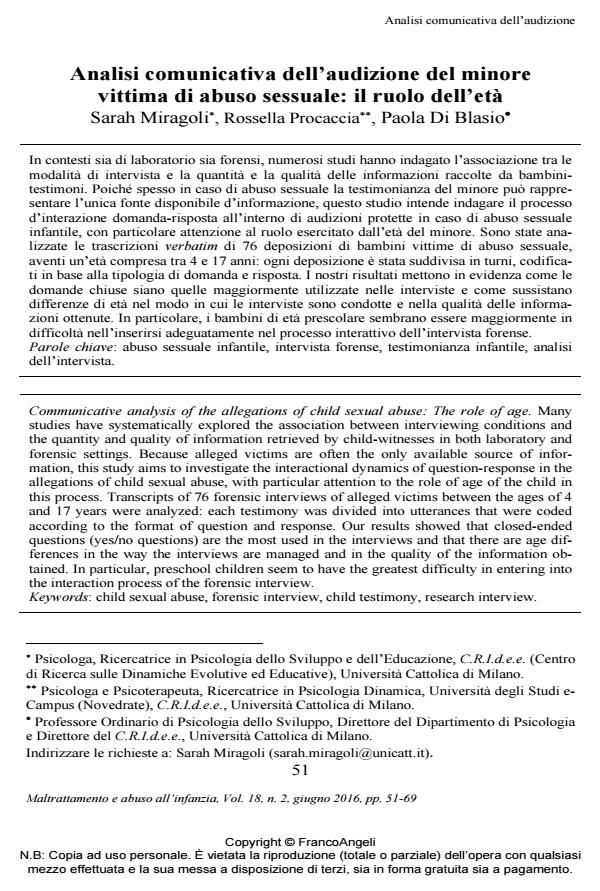Analisi comunicativa dell’audizione del minore vittima di abuso sessuale: il ruolo dell’età
Titolo Rivista MALTRATTAMENTO E ABUSO ALL’INFANZIA
Autori/Curatori Sarah Miragoli, Rossella Procaccia, Paola Di Blasio
Anno di pubblicazione 2016 Fascicolo 2016/2
Lingua Italiano Numero pagine 19 P. 51-69 Dimensione file 224 KB
DOI 10.3280/MAL2016-002004
Il DOI è il codice a barre della proprietà intellettuale: per saperne di più
clicca qui
Qui sotto puoi vedere in anteprima la prima pagina di questo articolo.
Se questo articolo ti interessa, lo puoi acquistare (e scaricare in formato pdf) seguendo le facili indicazioni per acquistare il download credit. Acquista Download Credits per scaricare questo Articolo in formato PDF

FrancoAngeli è membro della Publishers International Linking Association, Inc (PILA)associazione indipendente e non profit per facilitare (attraverso i servizi tecnologici implementati da CrossRef.org) l’accesso degli studiosi ai contenuti digitali nelle pubblicazioni professionali e scientifiche
In contesti sia di laboratorio sia forensi, numerosi studi hanno indagato l’associazione tra le modalità di intervista e la quantità e la qualità delle informazioni raccolte da bambini-testimoni. Poiché spesso in caso di abuso sessuale la testimonianza del minore può rappresentare l’unica fonte disponibile d’informazione, questo studio intende indagare il processo d’interazione domanda-risposta all’interno di audizioni protette in caso di abuso sessuale infantile, con particolare attenzione al ruolo esercitato dall’età del minore. Sono state analizzate le trascrizioni verbatim di 76 deposizioni di bambini vittime di abuso sessuale, aventi un’età compresa tra 4 e 17 anni: ogni deposizione è stata suddivisa in turni, codificati in base alla tipologia di domanda e risposta. I nostri risultati mettono in evidenza come le domande chiuse siano quelle maggiormente utilizzate nelle interviste e come sussistano differenze di età nel modo in cui le interviste sono condotte e nella qualità delle informazioni ottenute. In particolare, i bambini di età prescolare sembrano essere maggiormente in difficoltà nell’inserirsi adeguatamente nel processo interattivo dell’intervista forense.
Parole chiave:Abuso sessuale infantile, intervista forense, testimonianza infantile, analisi dell’intervista.
- Investigating linguistic coherence relations in child sexual abuse: A comparison of PTSD and non-PTSD children Sarah Miragoli, Elena Camisasca, Paola Di Blasio, in Heliyon e01163/2019 pp.e01163
DOI: 10.1016/j.heliyon.2019.e01163 - Completezza e coerenza narrativa in bambini sessualmente abusati: il ruolo dell'età e del PTSD Sarah Miragoli, Vittoria Badino, Elena Camisasca, in MALTRATTAMENTO E ABUSO ALL'INFANZIA 1/2022 pp.33
DOI: 10.3280/MAL2022-001003 - L'effetto di mediazione delle emozioni traumatiche nella relazione tra PTSD e coerenza narrativa in testimonianze di Child Sexual Abuse Sarah Miragoli, Luca Milani, in MALTRATTAMENTO E ABUSO ALL'INFANZIA 2/2019 pp.61
DOI: 10.3280/MAL2019-002005 - Focus monotematico. Testimonianza infantile e Child Sexual Abuse: ricerca e pratica Sarah Miragoli, Vittoria Badino, Elena Camisasca, in MALTRATTAMENTO E ABUSO ALL'INFANZIA 1/2022 pp.7
DOI: 10.3280/MAL2022-001001 - Coherence in Children’s Reports of Sexual Abuse: Age, PTSD, and Questioning Style Sarah Miragoli, Vittoria Badino, Elena Camisasca, in Journal of Forensic Psychology Research and Practice /2025 pp.772
DOI: 10.1080/24732850.2024.2364277 - How are sexually abused children interviewed during criminal proceedings in Italy? Sarah Miragoli, Rossella Procaccia, Elena Camisasca, Paola Di Blasio, in European Journal of Developmental Psychology /2020 pp.246
DOI: 10.1080/17405629.2019.1573665 - An Examination of the Synergy of Age and PTSD on Narrative Coherence in Child Sexual Abuse Testimony Sarah Miragoli, Elena Camisasca, in Journal of Child Sexual Abuse /2022 pp.743
DOI: 10.1080/10538712.2022.2131669 - Le emozioni dei bambini sessualmente abusati nelle audizioni protette: fattori individuali e situazionali Sarah Miragoli, Elena Camisasca, Paola Di Blasio, in RICERCHE DI PSICOLOGIA 3/2019 pp.483
DOI: 10.3280/RIP2019-003003 - Linee guida e protocolli per l'intervista del minore sessualmente abusato: una rassegna Claudia Scolari, in MALTRATTAMENTO E ABUSO ALL'INFANZIA 2/2016 pp.31
DOI: 10.3280/MAL2016-002003 - Narrative fragmentation in child sexual abuse: The role of age and post-traumatic stress disorder Sarah Miragoli, Elena Camisasca, Paola Di Blasio, in Child Abuse & Neglect /2017 pp.106
DOI: 10.1016/j.chiabu.2017.09.028 - Coerenza narrativa e frequenza dell'evento traumatico: un'analisi su deposizioni di abuso sessuale infantile Vittoria Badino, in MALTRATTAMENTO E ABUSO ALL'INFANZIA 3/2021 pp.73
DOI: 10.3280/MAL2020-003007
Sarah Miragoli, Rossella Procaccia, Paola Di Blasio, Analisi comunicativa dell’audizione del minore vittima di abuso sessuale: il ruolo dell’età in "MALTRATTAMENTO E ABUSO ALL’INFANZIA" 2/2016, pp 51-69, DOI: 10.3280/MAL2016-002004